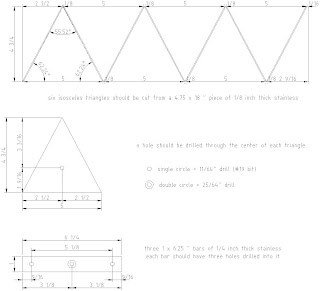


Well, despite the lack of posts from the last month, I've continued to tinker away on the scope and now have it in a form that pretty strongly resembles the final product.

For starters I painted everything. Rather, I used a black gloss stain-plus-polyurethane product from Minwax called Polywax to varnish all of the wood components. This is nice because it preserves a little of the grain, which is attractive. Although technically an indoor stain, the polyurethane should keep everything waterproof to the degree that I will need it to be.

I had to bisect the trunions, in order to allow the scope to collapse down to a portable size. I had to buy two 8" strap hinges made by Stanley to allow the trunions to bend in the middle and fold back on themselves. I also bought two somewhat heavy-duty draw-latches from McMaster-Carr to attach to the inside to secure the trunions in their extended position while viewing.

The bisected trunion design actually presents some significant design dillemmas. First, the strap hinges are not load rated, and there is what looks like a plastic washer in the hinge which prevents metal-metal contact. This plastic washer could be the site of failure, depending on just how much compressive force it can take. For now, though, it seems to be able to hold the full weight of the optical tube as I've been testing it. I had no way of knowing this at the outset, though, so this caused me much consternation when I was trying to choose what type of hinge to buy. Regardless, I am happy with these. I would still rather have the torque applied across the 16" span of the hinge, even with its plastic washer, than have it exclusively borne by the wooden trunions.
The second dillemma is that the extended portions of the trunions flex a small amount, despite being secured with the draw-latches. I still have to make a cross bar to hold the trunions the appropriate distance apart. While not difficult, this is still another piece of the scope that I'll have to set up prior to viewing. Also, it was surprisingly hard to find the tube-connecting nuts that I'm using for this bar. These nuts look like the plastic things on the end of ski poles, but they are made of metal and have a nut in the middle. You jam them in the end of a tube and they stay there and let you thread a bolt in parallel to the tube. Very useful, but not a single hardware store clerk in all of Seattle had ever heard of them.
All in all, the trunion issues makes me reconsider the ultra-compact design. Oh well, I can always build a classical mirror box in the future!
Next, I made the altitude bearings. I bought a 1/4" thick 6" x 6" teflon pad from onlinemetals.com. I sliced this into four 3" x 3/4" sized pads, and secured them to the base with flat head screws. The pads are about 20" apart on the base, which makes for a nice wide margin of error. If the center of gravity moves outside the pads when rotating the scope, it will tip over. So it's nice to have a relatively large margin of error, even though I think my estimate of the CG location is actually pretty accurate.

I then bought a couple of cheap vinyl wall-base panels, which I sliced into 3/4" x 20*pi/2" strips. I epoxied these strips to the trunions, using a Loc-tite gel-epoxy product that seemed to work well. I don't know the precise coefficient of friction between vinyl and teflon, and I think melamine-teflon may have it beat, since that is what is recommended in K&B. However, I couldn't find any melamine laminate, and I don't think it could be that dramatically different anyway.
That said, in my current design, the friction of the altitude bearing is significantly greater than that of the azimuth bearing, which, again, is a ball-bearing containing lazy-susan from McMaster. There are reasons why this may be nice. Tipping over is a significant risk, and is more likely if altitude bearings let the tube descend too quickly. Plus, at high latitudes such as Seattle (47 deg north), the azimuth bearing is more closely aligned with the Earth's axis than the altitude bearings are. When tracking objects as the Earth rotates, it's therefore more important to have an easy azimuth bearing. Again, that only applies at high latitudes. The opposite would be true at the equator, and as for San Diego (32 deg north), one would probably want both bearings to be easy! For that reason, I will probably purchase some track rollers from McMaster to use for the altitude bearings.

I finally drilled the truss tubes to secure the tube adapters in place. I will have to do this again after shortening the tubes when I know the exact focal length of the mirror. The whole optical tube is very rigid now.

That's most of the frame of the telescope. I still have have to make a tripod for the azimuth bearing to sit on, as well as the trunion strut, but these are pretty simple to do. I'll post about the optics next, but suffice it to say for now that the primary mirror has been commissioned!






























